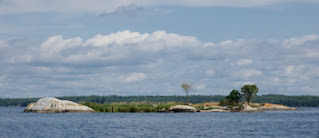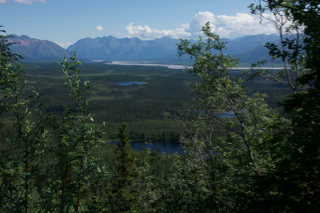 |
| Tombstone Valley, the Dempster Highway |
It's probably no surprise to our regular readers... the Dempster is my favorite road on the planet. It is always the highlight of our trips to this part of the world. I love it for its animals, its rugged remoteness, and for its surprises.
After hearing rumors of fires and road closures for weeks, we stopped at the Visitor's Center in Dawson City to check on road conditions. The Dempster was open. When we asked about the fires, the young lady said there may still be some smoke around KM marker 280, but that the fire was mostly out. She encouraged us to travel the road, saying the road was open all the way to Inuvik.
We didn't think to ask how big the fire was. We later learned that the aggressive blaze had begun with a lightening strike. It scorched over 325,000 acres. We traveled over twenty-five miles of road charred on either side from the enormous fire. We saw several still-smoldering plumes wafting from the remains of ghostly, blackened trees. Road crews were vigilant, traversing up and down hot spots. At the viewing platform on Olgivie Ridge, all we could see was the charred remains of boreal forests and high tundra grasses. This fire had been devastating.
 |
| Dempster boreal forest fire 2017 |
 |
| 2017 Dempster fire from Olgivie Ridge |
We had never been up the Dempster in the middle of summer. Normally we travel as autumn begins in late August or early September. This trip was so much different. We have always seen all kinds of animals. But between the fire and the time of year, this trip's sightings were scarce. When we did see animals, they were skittish and visible for only seconds. Near the fire remains we saw a moose cow and calf, a young black bear, and a black wolf crossing the road. At the sound of our truck, they disappeared quickly. I was only able to photograph the little black bear.
 |
| Black bear grazing on Dempster Highway |
After boondocking at a favorite spot near Eagle River, we stopped at Eagle Plains the following morning for breakfast. We spoke with the manager who was also devastated by the fire. She told us that she feared mostly for the caribou. The fire had scorched so much earth that she wondered if the tundra grasses could now support the herd this winter. We told her that normally we see mother bears grazing with their cubs near Eagle Plains. She told us arial photos showed that the fire had driven them all north. We all feared that many animals had lost their lives.
As we neared the Yukon/Northwest Territory border, we were shocked to see a large herd of caribou grazing in the distant meadow. It was the wrong time of year to see these magnificent animals, particularly in such great numbers. Normally this area is their winter feeding grounds. Perhaps the fire had driven them down from the high country.
We were also shocked to see hunters... dozens of them. We couldn't believe hunting would be allowed in July. Through binoculars, we could see several hunters field dressing their kill.
 |
| Caribou on the Dempster in July |
With all the hunting activity, we drove on and stopped in Fort McPherson to check on our friend Robert who runs the provincial campground and visitors center. Another man met us, explaining that Robert had been ill but was doing better after treatment. I told him that Robert had always asked us for a caribou report and that we had seen several hundred at the border. We also told him that we had seen hunters.
He shook his head. His voice contained sadness. He said it was a rare gift to have caribou in the valley in the summer. The people should not be hunting... they didn't need the meat now. They should let the caribou settle in and become comfortable. He told us that the tribe had sent elders to speak with the hunters and try to dissuade them.
In this part of Canada, the local Gwich'in tribes regulate the hunting season. This man was obviously one of the elders and was distraught over the turn of events.
It was still early in the afternoon. Hoping to see more animals, we made the decision to drive all the way to Inuvik. Perhaps we would see black bear in the Delta. There were none.
We arrived at Jak Provincial Park around six that evening and set up camp in misty rain. By the time we had showers, the clouds parted, and the sun reappeared.
The town of Inuvik sits above the Arctic Circle, and we were obviously still in the land of the midnight sun. I took this photo from inside the camper at 2:30 in the morning. The sun didn't quite set. It simply skirted the horizon for a bit before rising again.
 |
| A Dempster sunset... 2:30 am in July |
The next morning, we drove into the town of Inuvik and discovered that our favorite cafe had closed. The lady at the visitors center told us that the cafe's owner had passed away suddenly. She also told us that the anticipated new road extension to Tuk had been delayed until November. It definitely felt like we had hit the end of the road.
We decided to turn around and drive back south. When we arrived again at the border, we saw several trucks and men but no hunters. Perhaps these were the elders sent to discourage hunters. It was hard to believe that we had been here just 24 hours earlier and the place had been buzzing with activity. Now it appeared desolate. The caribou herd had vanished. Using his binoculars, David scoured the horizon for signs of life. Off in the very far distance, he spied a grizzly bear, probably grazing a gut pile from a caribou kill. We camped at Rock Springs, with plans to drive back to the border next morning. Surely we would see animals. We didn't. Even the elders were gone.
We felt disheartened. Everything seemed different on the Dempster this trip. We made the decision to leave the next morning.
 |
| On the Dempster Highway, between Tombstone and Two Moose Lake |
Our last night on the Dempster, we camped in a favorite spot near a field of fireweed. Fireweed is so named because in a temperate forest, it is the first plant to colonize after a fire.
Surely, these flowers were a good omen. We will plan another trip up the Dempster, perhaps even returning next fall. Our prayer is that the fireweed will grow, and the Dempster and its animals will continue to thrive.
 |
| Fireweed on the Dempster Highway |











































